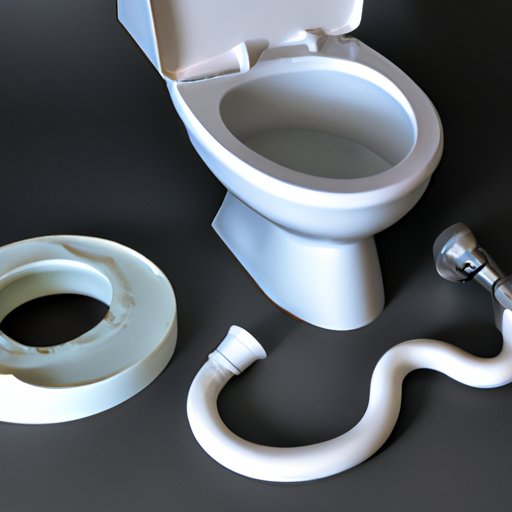Introduction
Dealing with a clogged toilet can be a frustrating experience, but snaking a toilet is a simple solution. Snaking a toilet involves working with a drain cleaning tool designed to remove blockages in the toilet’s drainpipe. This helpful guide explores the necessary steps, tools, and hazards associated with snaking a toilet.
The guide is aimed at homeowners and renters who are confident in performing basic plumbing tasks and interested in learning how to handle toilet clogs before calling in a professional plumber.
Step-by-Step Guide on How to Snake a Toilet
The following instructions guide you through the process of snaking a toilet:
1. Prepare the Toilet
Turn off the toilet water supply from the valve behind the toilet. Place newspapers or towels around the toilet base to protect the floor. Wear gloves and safety goggles for added protection.
2. Position the Snake
Insert the toilet auger’s end into the toilet bowl drain hole and push through the P-trap. Keep pushing the auger until you feel resistance.
3. Turn the Handle
Turn the handle clockwise to help the snake work through the blockage. You’ll feel some resistance, which means the snake is working effectively. Keep turning the handle until you break through the clog and the snake begins turning more easily.
4. Retrieve the Snake
Slowly remove the toilet auger from the toilet drain and avoid pulling too hard so that the snake does not bend or break. Dispose of any waste in the toilet bowl before turning on the water to flush out any remaining particles.

Common Problems and Solutions
Toilet clogs can stem from a variety of reasons such as flushing inappropriate items or buildup of mineral deposits. Snaking can address common clogs and the following steps can solve a range of issues:
1. Flushing Inappropriate Items
Items such as napkins, hygiene products, or waste materials can lead to blockages. To avoid such problems, ensure only suitable materials such as toilet tissue go down the drain.
2. Mineral Buildup
Hard water creates mineral buildup that can lead to clogs in the toilet. To address mineral buildup, use vinegar or other water softeners periodically.
3. Foreign Objects
Foreign objects such as toys can become lodged in the drain, causing significant blockages. Snaking a toilet can solve this problem.
The Dos and Don’ts of Snaking a Toilet
To perform snaking efficiently and safely, follow these recommendations:
The Dos
- Wear gloves and safety goggles to protect your hands and eyes.
- Read the manual that comes with the auger to understand how to work the tool.
- Position the auger carefully to avoid scratching the toilet bowl’s surface.
- Be patient and avoid rushing through the process.
The Don’ts
- Don’t use a plunger and a toilet auger together as it can lead to injuries.
- Avoid using chemicals unless you’re familiar with the products, their instructions, and the potential hazards associated with using them.
- Do not exert more pressure than needed. Push gently and let the auger do the job.
- Avoid creating a kink in the snake as it can limit effectiveness and result in frustration.
Tools You Need
The following tools are required for snaking a toilet:
- Toilet Auger-Snake
- Gloves
- Safety goggles
- Newspapers or towels
It’s recommended to have all the necessary equipment in one place for easier access.
Safety Precautions
Safety is paramount when it comes to snaking a toilet. The following are some safety tips to follow:
1. Wear Proper Protection
Ensure you wear gloves, safety goggles, and any protective gear recommended in the manual to avoid exposing yourself to contaminants or sharp edges.
2. Avoid Sharp Edges
Be cautious when working with the auger by avoiding any sharp edges to protect yourself and the toilet bowl.
3. Be Careful When Handling the Snake
Handle the auger carefully and never force it down the toilet. Use proper positioning and apply gentle force and patience.
Tips for Dealing with Stubborn Blockages
Stubborn blockages may require a more complex solution which calls for a toilet plunger or drain cleaner, but these are not recommended for novice users. Consider these options to address more stubborn blockages:
- Use a plunger if the clog is not too severe.
- Consider calling a professional plumber if the problem persists.
When to Call a Plumber
Some problems can indicate a severe blockage that requires professional plumbing expertise to resolve. The following are instances when calling a plumber could be necessary
- When flushing the toilet causes sewage to move back into the house.
- If numerous attempts to fix the issue with snaking fail.
- If the toilet stops flushing altogether.
It’s essential to research and choose a reliable professional plumber to avoid poor service delivery, unsatisfactory results, or further damage.
Conclusion
Snaking a toilet is a relatively simple process that any homeowner or renter can do. Learning how to do it and being confident in your ability can save you costs associated with hiring a professional to address the issue. However, it’s essential to be cautious and follow safety guidelines to avoid injuries and further damage.
By applying the steps, tips, and precautions outlined in this guide, you can enjoy a well-functioning toilet and avoid the frustration of dealing with a clogged toilet.
